| Rating: |
|
7 Ratings |
| Your rating: |
|
Sign in to rate
|
Inklingo 'Layer to Cut' for Machine Piecing
LAYER TO CUT is a simple concept, but it opens our thinking to exciting, easy, accurate methods.
It is so simple that it is easy to underestimate its advantages.
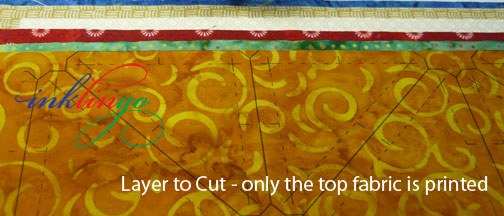
LAYER TO CUT uses a sheet of fabric like a
ruler or
template.
We print the shapes on fabric with Inklingo and any ordinary Inkjet printer.
A sheet of fabric doesn’t slide around the way acrylic does and since precise cutting lines are marked, there is no measuring.
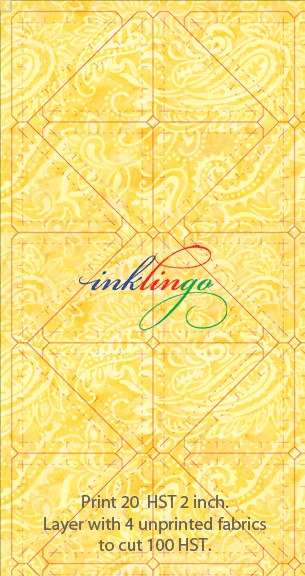
Example:
To cut 100 Half Square Triangles (HST 2 inch size) for
machine piecing, you only need to print one fabric with 20 triangles. Layer the printed fabric with 4 unprinted fabrics and use the top layer as a cutting guide. Cut all 5 layers at once.
Since all Inklingo shapes are named with the
FINISHED size, you don't need math or measuring—or weird
ruler instructions!
We do not normally need stitching lines for
machine piecing. All of the triangles will be perfect—with no measuring and no
dog ears, so the seams align perfectly!
Inklingo layouts are carefully designed to use fabric efficiently and there is often a choice to suit scraps and strips.

Example:
If you print two-inch HST with Layout 2, you can cut the printed sheet into rows to fit on 2.5 inch strips of fabric. It's the same for hexagons or any other shape.
LAYER TO CUT requires even less ink than would be used to print every shape for a quilt.
1. Simplify the printing!
• Print the lightest fabric so the cutting lines are easy to see.
• Difficult-to-print fabrics don’t need to be printed at all.
• Only one fabric is tested to choose the right ink color.
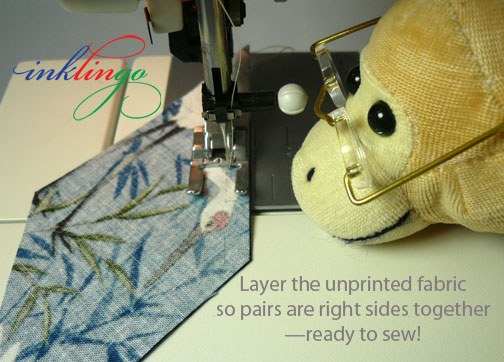 2. Machine piecing is faster, easier and more accurate!
2. Machine piecing is faster, easier and more accurate!
• Layer pairs of fabrics right sides together, so the shapes will be ready to pick up two at a time for
chain piecing.
• Mirror images can be achieved just by layering fabrics right side up or wrong side up in relation to the printed sheet.
• Pinning the layers together is not usually necessary, but you can
press first to prevent shifting, if necessary.
3. Using scraps and odd bits of fabric is efficient.
• Print a large sheet of fabric for efficiency and cut it into sizes that can be layered on small pieces or strips.
• Layer to Cut makes very efficient use of fabric. Trim the margins from the printed fabric before layering with unprinted fabrics.
 4. Great design opportunities!
4. Great design opportunities!
• The unprinted layers can be made up of fabrics that have already been
strip pieced or string pieced. (Wow!)
•
Muslin or other inexpensive fabrics can be printed to use as “disposable rulers”—and then tossed.
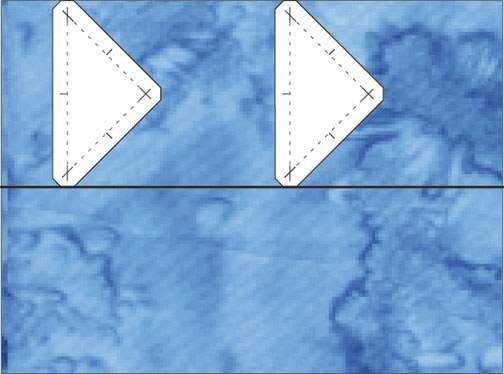 5. A variation allows you to treat a single shape like a template.
5. A variation allows you to treat a single shape like a template.
• A single shape can be printed on fabric or
template material to cut more shapes—no measuring, and everything identical.
• Instead of measuring, cut one shape to use as a
template to establish the width required for strips (and layers of strips).
TIP Use two cutting mats!
Use a large
cutting mat for cutting yardage and freezer paper. Use a smaller mat for cutting printed sheets of fabric, so you can turn the mat without disturbing the fabric.
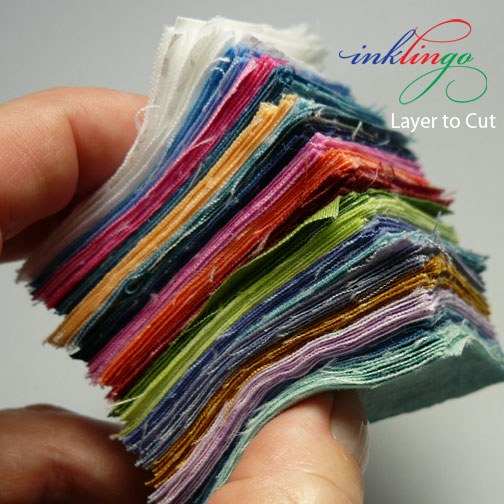
LAYER TO CUT works any time you don't need the sewing lines on every shape. I use it when I am cutting triangles for
machine piecing or hexagons for
paper piecing.
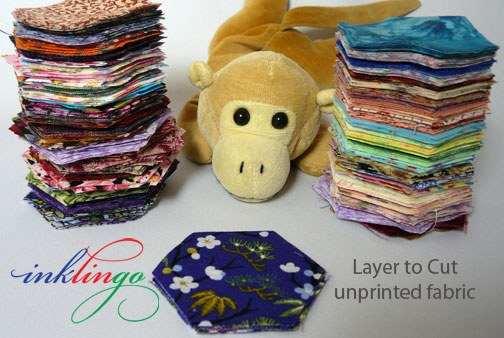
Check This Out!
Check out the most popular tool on QuiltingHub. Use the search 'Map Of Resources' or the 'Resources Trip Planner' to the right (or below).
Glossary
- Chain Piecing
-
Sewing blocks or sections of blocks in an assembly line fashion, completing the same step for each unit in sequence. An efficient way to work for sewing many blocks that are the same. If the pieces are all run through the machine and cut apart later.
Same As: Assembly Piecing
See Also: English Paper Piecing, Assembly Piecing, Machine Piecing, Paper Piecing, Hand Piecing, Piecing
- Cutting Mat
-
Surface used for cutting with a rotary cutter. The mat protects your tabletop and can serve as a measuring tool when you use the gridlines on the mat to line up your fabric. Many mats are self-healing which means that the blade of the rotary cutter will not create permanent grooves in the mat.
- Dog Ears
-
Long points that extend beyond the seam allowance. Usually this happens with triangles or diamonds, and it is a good idea to trim them so your quilt back has less bulk.
- Finished Size
-
The final sewn measurement or dimensions of a completed block without seam allowances. Thus a 6" sewn measurement block would be cut 6.5" to allow for 1/4" seam allowances.
- Machine Piecing
-
Sewing patches in a quilt block together using a sewing machine instead of sewing them together by hand.
See Also: English Paper Piecing, Assembly Piecing, Chain Piecing, Paper Piecing, Hand Piecing, Piecing
- Muslin
-
A type of loosely-woven cotton fabric, introduced to Europe from the Middle East in the 17th century. It became very popular at the end of the 18th century in France. Muslin is most typically a closely-woven unbleached or white cloth, produced from corded cotton yarn. Wide muslin is called "sheeting". It is often used to make dresses or curtains but may be used to complement foam for bench padding. Muslin breathes well, and is a good choice of material for clothing meant for hot, dry climates.
- Paper Piecing
-
A method of hand piecing using paper templates of shapes to assist you with cutting, piecing and sewing accurately. The paper is used as a guide for sewing and then later removed.
See Also: English Paper Piecing, Assembly Piecing, Machine Piecing, Chain Piecing, Hand Piecing, Piecing
- Press
-
Method of using an iron to press seams and blocks. This means simply pressing downwards on the seam with the iron from above and not moving the iron back and forth which can distort the block or seam.
- Ruler
-
A heavy plastic measuring guide that can come in a variety of shapes and sizes.
- Strip
-
A construction technique in which long, narrow pieces of cloth are joined lengthwise, sometimes with long rows of quilt blocks, to form a quilt top. The term "strip" can be used to describe the long pieces of fabric between blocks (see Sashing) or to describe the small, narrow remnants used in string patchwork.
See Also: Sashing
- Template
-
Pattern pieces made out of paper, cardboard, plastic or metal, giving you something to draw around so that you can accurately replicate any shape.